Properties of Green Foam-Type Composites Made from Recycled Paper and Cardboard
Abstract
1. Introduction
2. Results and Discussion
2.1. Vertical Density Profile of the Samples
2.2. Dimensional Stability of the Samples
2.3. Thermal Conductivity of the Samples
2.4. Sound Absorption Coefficient α
2.5. Microscopic Investigation
2.6. Mechanical Properties of the Samples
2.7. Fourier-Transform Infrared Spectroscopy
3. Materials and Methods
3.1. Preparation of Composites
3.2. Methods
3.2.1. Vertical Density Profile
3.2.2. Thermal Conductivity
3.2.3. Dimensional Stability
3.2.4. Sound Absorption
3.2.5. Porosity of the Samples
3.2.6. Mechanical Properties
3.2.7. Microscopic Analysis
3.2.8. FTIR Analysis
3.2.9. Statistical Analysis
4. Conclusions
Author Contributions
Funding
Data Availability Statement
Acknowledgments
Conflicts of Interest
Abbreviations
| ATR | Attenuated total reflectance unit |
| C | Foam-type composite from cardboard |
| FTIR | Fourier Transform Infrared Spectroscopy |
| MOR | Modulus of Rupture |
| MOE | Modulus of Elasticity |
| NRC | Noise Reduction Coefficient |
| PC | Foam-type composite from paper and cardboard blended |
| P | Foam-type composite from paper |
| SAA | Sound Absorption Average |
| TFM | Transfer function method |
| VDP | Vertical density profile |
References
- Kang, C.W.; Kim, M.K.; Jang, E.S. An Experimental Study on the Performance of Corrugated Cardboard as a Sustainable Sound-Absorbing and Insulating Material. Sustainability 2021, 13, 5546. [Google Scholar] [CrossRef]
- Mathews, J.M.; Vivek, B.; Charde, M. Thermal insulation panels fabricated using recycled cardboard for energy efficiency in buildings: Retrofit performance evaluation in hot climate. Int. J. Sustain. Energy 2025, 44, 2432280. [Google Scholar] [CrossRef]
- Kobayashi, J.; Kaneko, M.; Supachettapun, C.; Takada, K.; Kaneko, T.; Kim, J.Y.; Ishida, M.; Kawai, M.; Mitsumata, T. Mechanical Properties and Reinforcement of Paper Sheets Composited with Carboxymethyl Cellulose. Polymers 2024, 16, 80. [Google Scholar] [CrossRef]
- Sun, W.; Strässle Zúñiga, S.H.; Philippe, V.; Rinaldi, L.; Abitbol, T. Mycelium-Bound composites from agro-industrial waste for broadband acoustic absorption. Mater. Des. 2025, 250, 113591. [Google Scholar] [CrossRef]
- Walter, N.; Gürsoy, B. A Study on the Sound Absorption Properties of Mycelium-Based Composites Cultivated on Waste Paper-Based Substrates. Biomimetics 2022, 7, 100. [Google Scholar] [CrossRef]
- Ouakarrouch, M.; Bousshine, S.; Bybi, A.; Laaroussi, N.; Garoum, M. Acoustic and thermal performances assessment of sustainable insulation panels made from cardboard waste and natural fibers. Appl. Acoust. 2022, 199, 109007. [Google Scholar] [CrossRef]
- Kochersperger, S.; Schabel, S. Recyclability of Paper-Based Composites for Packaging Applications—The Role of Evaluation Methods. Chem. Ing. Tech. 2024, 96, 891–901. [Google Scholar] [CrossRef]
- Haigh, R.; Sandanayake, M.; Yaghoubi, E.; Joseph, P.; Vrcelj, Z. The mechanical and microstructural investigations of concrete incorporating waste textile and cardboard fibers following thermal and freeze–thaw cycles. Struct. Concr. 2025, 26, 2757–2772. [Google Scholar] [CrossRef]
- Faria, D.L.; Mesquita Junior, L.; do Lago, R.C.; Soriano, J.; Guimaraes Junior, M.; Pires, N.J.; da Silva Bezerra, A.C.; de Oliveira, J.E.; de Paula Protasio, T.; Martins, M.A.; et al. Valorization of cardboard waste in the production of polyurethane biocomposites: A new and environmentally friendly material for civil construction. Constr. Build. Mater. 2025, 462, 139902. [Google Scholar] [CrossRef]
- Mathews, J.M.; Vivek, B.; Charde, M. Thermal insulation panels for buildings using recycled cardboard: Experimental characterization and optimum selection. Energy Build. 2023, 281, 112747. [Google Scholar] [CrossRef]
- Luo, S.; Gao, L.; Guo, W. Influence of Adding Lignin and Wood as Reactive Fillers on the Properties of Lightweight Wood–Polyurethane Composite Foams. Forest Prod. J. 2020, 70, 420–427. [Google Scholar] [CrossRef]
- Wahab, H.A.; Rus, A.Z.M.; Moen, A.T.; Ngadimon, K.N.; Noor, F.M. Optimization of Acoustical Properties Polyurethane (PU) Wood Fibres Foam Composites. In Proceedings of the ICME 2019, Ayer Keroh, Melaka, Malaysia, 29–30 August 2019; IOP Conference Series: Materials Science and Engineering. IOP Publishing: Bristol, UK, 2020; Volume 824, p. 012016. [Google Scholar]
- Luo, S.; Gao, L.; Guo, W. Effect of incorporation of lignin as bio-polyol on the performance of rigid lightweight wood–polyurethane composite foams. J. Wood Sci. 2020, 66, 23. [Google Scholar] [CrossRef]
- Aramburu, A.B.; Guidoti, A.B.; Schneider, D.M.; Cruz, N.D.; Delucis, R.A. Colour of polyurethane foams filled with wood and wood derivatives exposed to two xylophagous fungi. J. Cell. Plast. 2022, 58, 541–553. [Google Scholar] [CrossRef]
- Li, J.; Yang, X.; Xiu, H.; Dong, H.; Song, T.; Ma, F.; Feng, P.; Zhang, X.; Kozliak, E.; Ji, Y. Structure and performance control of plant fiber based foam material by fibrillation via refining treatment. Ind. Crops Prod. 2019, 128, 186–193. [Google Scholar] [CrossRef]
- Khedr, R.F.; Elnahas, H.H. Preparation of wood plastic composite from flax fibers and post consumed polystyrene foam based on environmental and economical scales. J. Thermoplast. Compos. Mater. 2024, 37, 869–884. [Google Scholar] [CrossRef]
- Chen, G.; Gupta, A.; Mekonnen, T.H. Effects of wood fiber loading, silane modification and crosslinking on the thermomechanical properties and thermal conductivity of EPDM biocomposite foams. Ind. Crops Prod. 2023, 200, 116911. [Google Scholar] [CrossRef]
- Mazaherifar, M.H.; Timar, C.M.; Georgescu, S.V.; Coșereanu, C. Sustainable thermal and acoustic insulating panels from recycled cardboard. BioResourses 2025, 20, 4115–4135. [Google Scholar] [CrossRef]
- Fauzi, M.S.; Lan, D.N.; Osman, H.; Ghani, S.A. Effect of sodium bicarbonate as blowing agent on production of epoxy shape memory foam using aqueous processing method. Sains Malays. 2015, 44, 869–874. [Google Scholar] [CrossRef]
- Hussein, M.S.; Leng, T.P.; Rahmat, A.R.; Zainuddin, F.; Keat, Y.C.; Suppiah, K.; Alsagayar, Z.S. The effect of sodium bicarbonate as a blowing agent on the mechanical properties of epoxy. Mater. Today Proc. 2019, 16, 1622–1629. [Google Scholar] [CrossRef]
- Mikhailidi, A.M.; Saurov, S.K.; Markin, V.I.; Kotelnikova, N.E. Functional materials from paper wastes: I. From waste newsprint paper and cardboard to high-grade cellulose fibers. Russ. J. Bioorg. Chem. 2019, 45, 888–894. [Google Scholar] [CrossRef]
- Tajvidi, M.; Azad, F. Effect of particle size, fiber content and compatibilizer on the long-term water absorption and thickness swelling behavior of reed flour/polypropylene composites. J. Reinf. Plast. Compos. 2009, 28, 2341–2351. [Google Scholar] [CrossRef]
- Rebolledo, P.; Cloutier, A.; Yemele, M.C. Effect of density and fiber size on porosity and thermal conductivity of fiberboard mats. Fibers 2018, 6, 81. [Google Scholar] [CrossRef]
- Rutkevičius, M.; Austin, Z.; Chalk, B.; Mehl, G.H.; Qin, Q.; Rubini, P.A.; Stoyanov, S.D.; Paunov, V.N. Sound absorption of porous cement composites: Effects of the porosity and the pore size. J. Mater. Sci. 2015, 50, 3495–3503. [Google Scholar] [CrossRef]
- Luo, X.; Li, W.; Jin, X.; Zeng, L. Effects of porosity and pore size on sound absorption characteristic of ceramsite porous material. J. Chin. Ceram. Soc. 2011, 39, 158–163. [Google Scholar]
- Istana, B.; Batan, I.M.L.; Sutikno Khem, S.; Ubaidillah, U.; Yahya, I. Influence of particle size and bulk density on sound absorption performance of oil palm frond-reinforced composites particleboard. Polymers 2023, 15, 510. [Google Scholar] [CrossRef]
- Wang, X.; Sotoudehniakarani, F.; Yu, Z.; Morrell, J.J.; Cappellazzi, J.; McDonald, A.G. Evaluation of corrugated cardboard biochar as reinforcing fiber on properties, biodegradability and weatherability of wood-plastic composites. Polym. Degrad. Stab. 2019, 168, 108955. [Google Scholar] [CrossRef]
- Schwanninger, M.; Rodrigues, J.C.; Pereira, H.; Hinterstoisser, B. Effects of short-time vibratory ball milling on the shape of FTIR spectra of wood and cellulose. Vib. Spectrosc. 2004, 36, 23–40. [Google Scholar] [CrossRef]
- Manandhar, S.; Shrestha, B.; Sciortino, F.; Ariga, K.; Shrestha, L.K. Recycling Waste Paper for Further Implementation: XRD, FTIR, SEM, and EDS Studies. J. Oleo Sci. 2022, 71, 619–626. [Google Scholar] [CrossRef]
- Pandey, K.K.; Pitman, A.J. FTIR studies of the changes in wood chemistry following decay by brown-rot and white-rot fungi. Int. Biodeterior. Biodegrad. 2003, 52, 151–160. [Google Scholar] [CrossRef]
- Mazaherifar, M.H.; Coşereanu, C.; Timar, C.M.; Georgescu, S.V. Physical and mechanical properties of foam-type panels manufactured from recycled cardboard. Constr. Build. Mater. 2024, 411, 134685. [Google Scholar] [CrossRef]
- Xu, H.; Huang, L.; Xu, M.; Qi, M.; Yi, T.; Mo, Q.; Zhao, H.; Huang, C.; Wang, S.; Liu, Y. Preparation and Properties of Cellulose-Based Films Regenerated from Waste Corrugated Cardboards Using [Amim]Cl/CaCl2. ACS Omega 2020, 5, 23743–23754. [Google Scholar] [CrossRef] [PubMed]
- Goué, E.L.; Ham-Pichavant, F.; Grelier, S.; Remy, J.; Coma, V. Functional Chitosan–Calcium Carbonate Coatings for Enhancing Water and Fungal Resistance of Paper Materials. Molecules 2022, 27, 8886. [Google Scholar] [CrossRef] [PubMed]
- Matei, C.; Berger, D.; Dumbrava, A.; Radu, M.; Gheorghe, E. Calcium carbonate as silver carrier in composite materials obtained in green seaweed extract with topical applications. J. Sol-Gel Sci. Technol. 2020, 93, 315–323. [Google Scholar] [CrossRef]
- www.spentopapers.com. Available online: https://spentopapers.com/pages/coated-vs-uncoated-paper (accessed on 15 September 2025).
- www.shimadzu-webapp.eu. Available online: https://www.shimadzu-webapp.eu/magazine/issue-2017-3_en/just-paper-isnt-it/ (accessed on 15 September 2025).
- Mihoubi, W.; Sahli, E.; Gargouri, A.; Amiel, C. FTIR spectroscopy of whole cells for the monitoring of yeast apoptosis mediated by p53 over-expression and its suppression by Nigella sativa extracts. PLoS ONE 2017, 12, e0180680. [Google Scholar] [CrossRef] [PubMed]
- ISO 8301:1991; Determination of Steady-State Thermal Resistance Properties. Heat Flow Meter Apparatus. Latvian Standard; International Organization for Standardization: Riga, Latvia, 1991.
- Institution, B.S. Thermal Performance of Building Materials and Products: Determination of Thermal Resistance by Means of Guarded Hot Plate and Heat Flow Meter Methods: Products of High and Medium Thermal Resistance; British Standards Institution: London, UK, 2001. [Google Scholar]
- EN 317:1996; Particleboards and Fibreboards–Determination of Swelling in Thickness after Immersion in Water. European Committee for Standardization: Brussels, Belgium, 1996.
- ISO 10534:1998; Acoustics—Determination of Sound Absorption Coefficient and Impedance in Impedance Tubes: Part 1: Method Using Standing Wave Ratio, Part 2: Transfer-Function Method. International Organization for Standardization (ISO): Geneva, Switzerland, 1998.
- ASTM E1050:1998; Standard Test Method for Impedance and Absorption of Acoustical Materials Using a Tube, Two Microphones and a Digital Frequency Analysis System. ASTM International: West Conshohocken, PA, USA, 1998.
- EN 326-1; Wood-Based Panels–Sampling, Cutting and Inspection–Part 1: Sampling and Cutting of Test Pieces and Expression of Test Results. European Committee for Standardization: Brussels, Belgium, 1994.
- EN 310; Wood-Based Panels. Determination of Modulus of Elasticity in Bending and Bending Strength. European Committee for Standardization: Brussels, Belgium, 1993.
- EN 319; Particleboards and Fiberboards. Determination of Tensile Strength Perpendicular to the Plane of the Board. European Committee for Standardization: Brussels, Belgium, 1993.
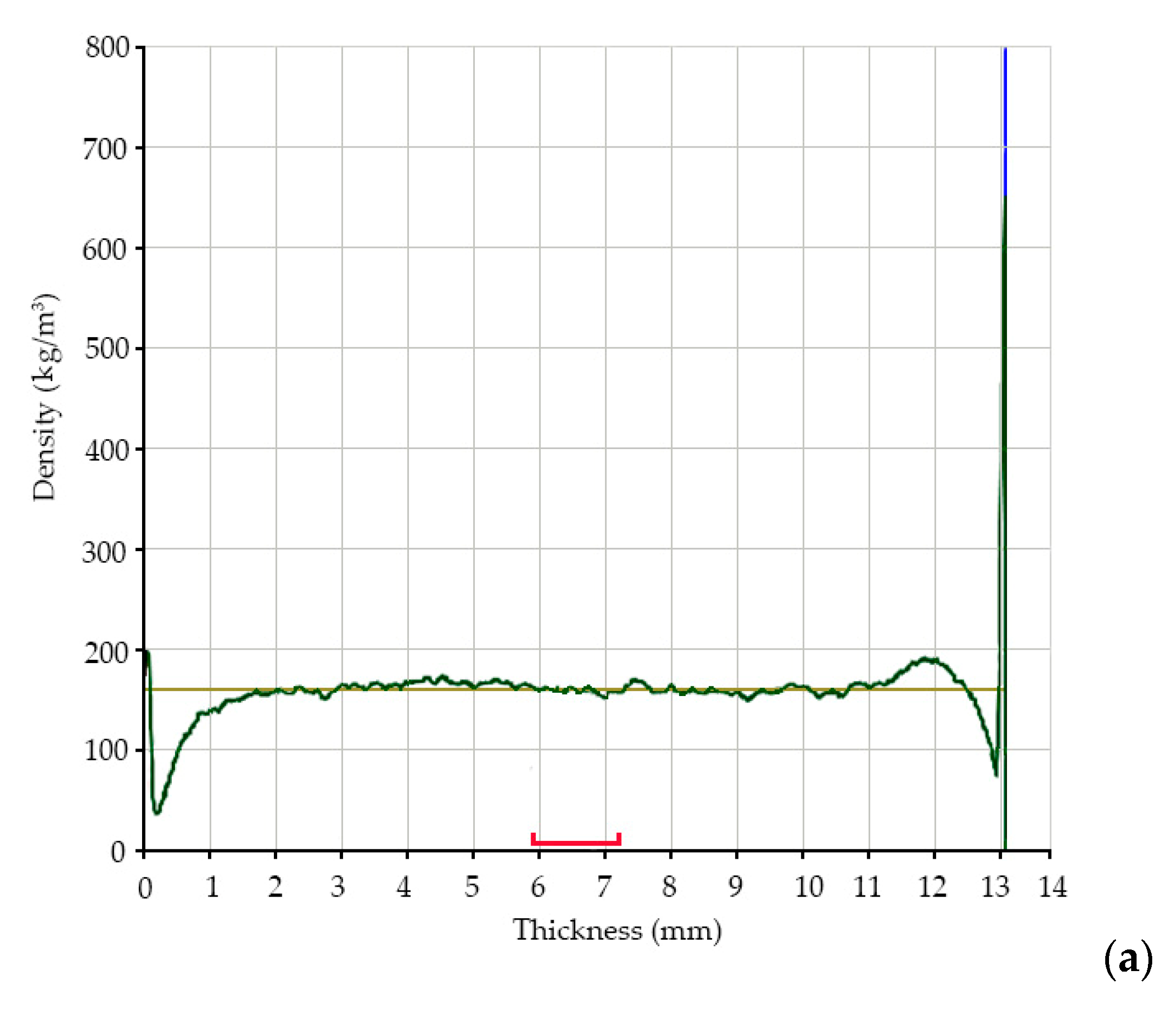
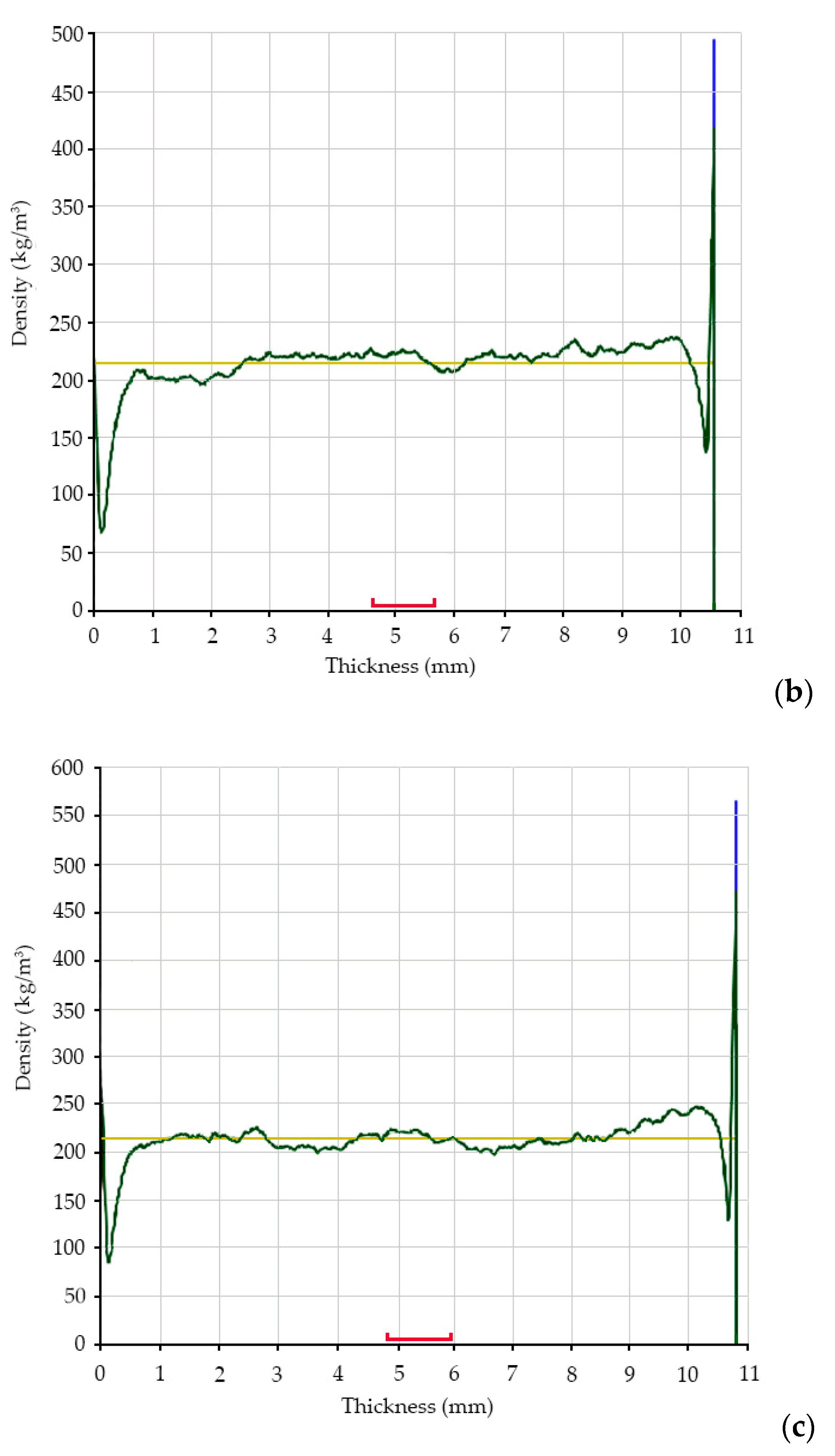
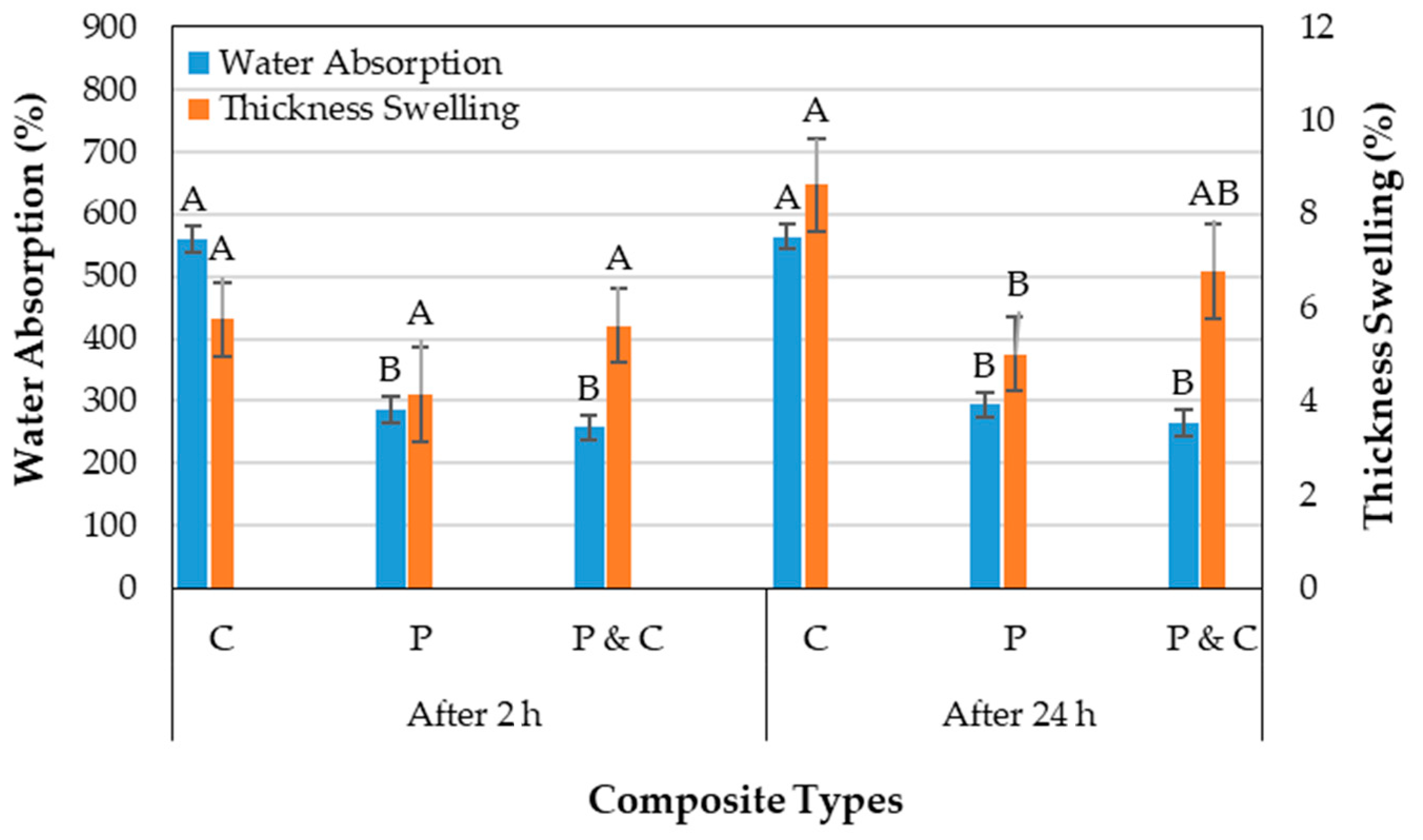
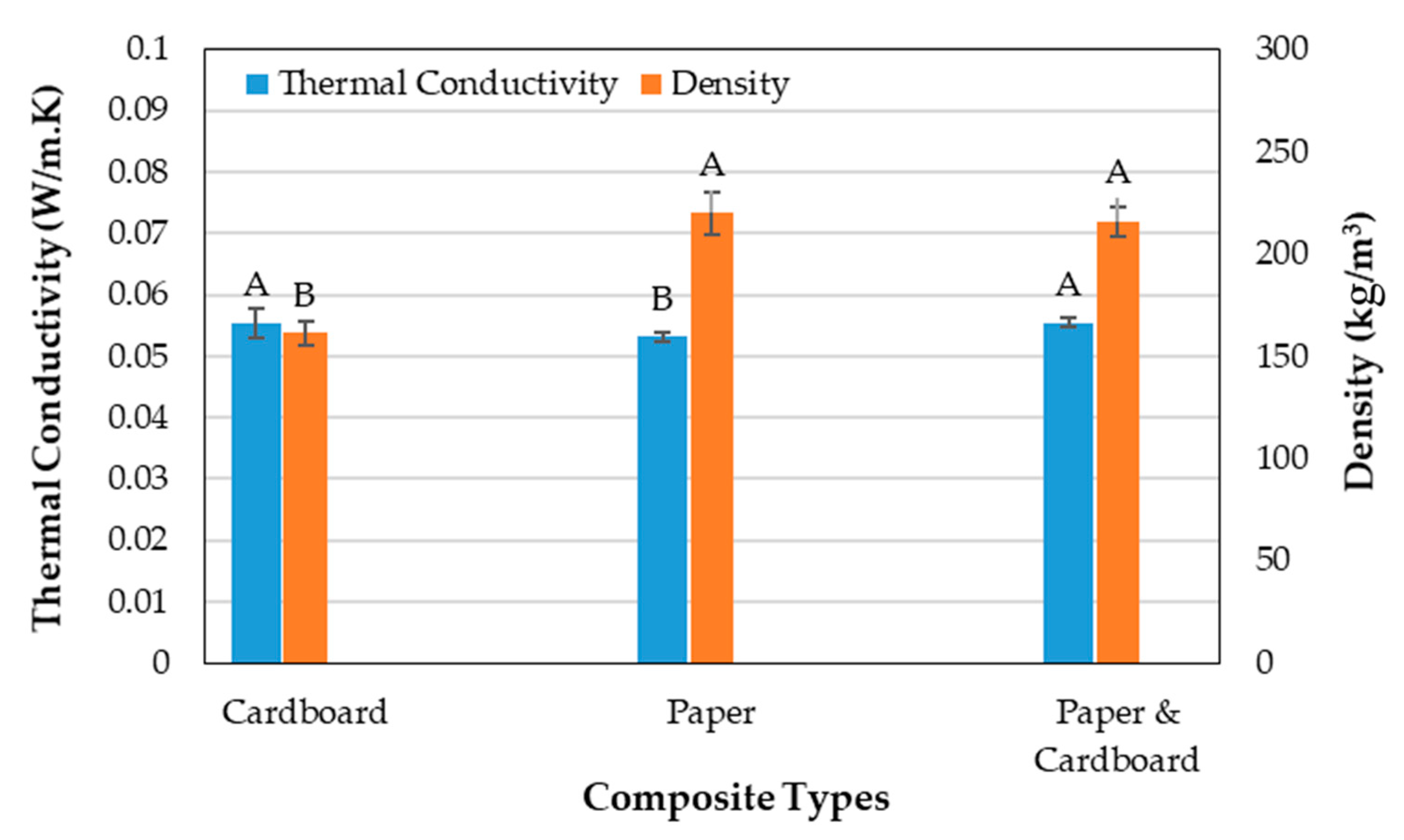
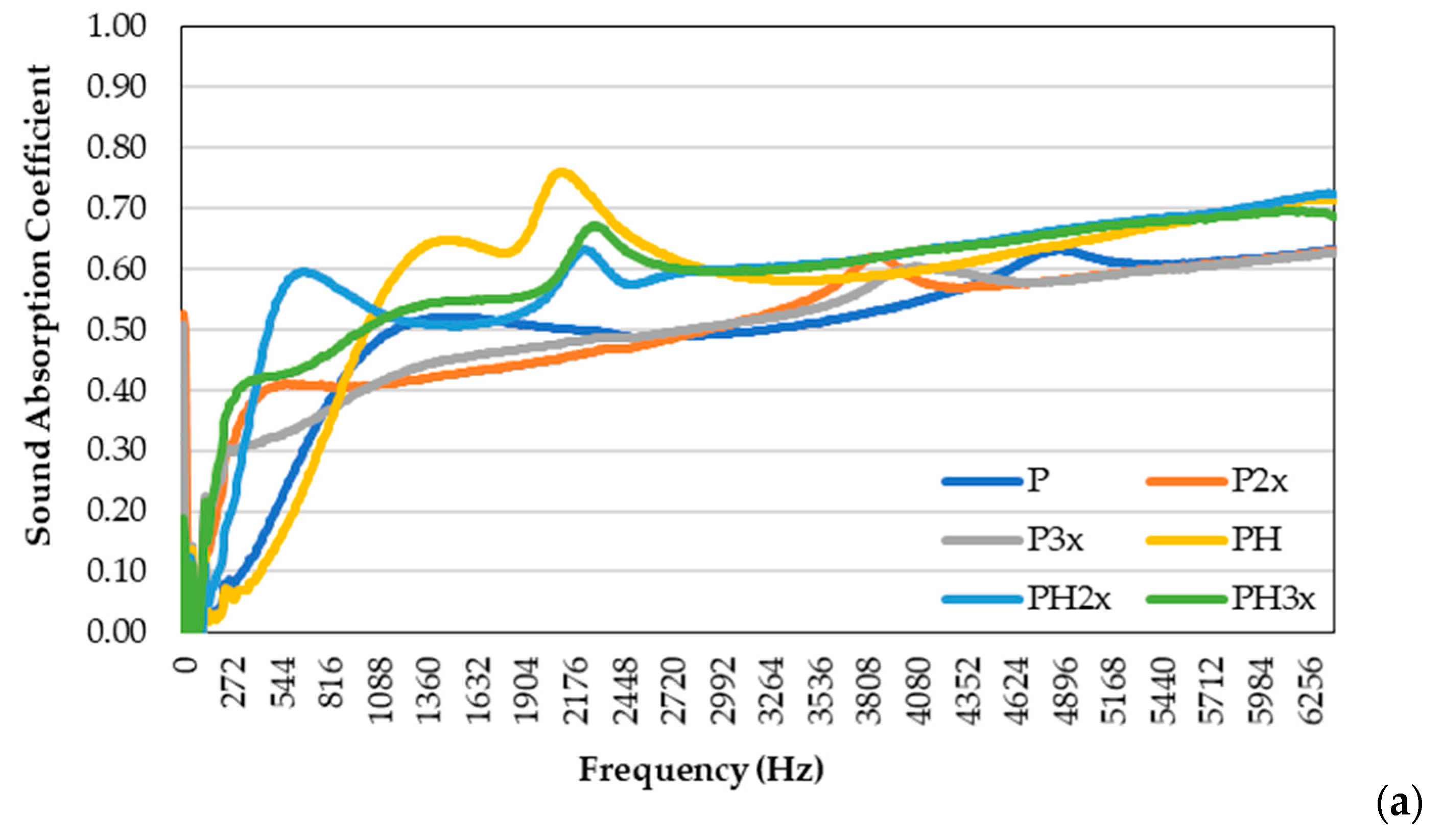
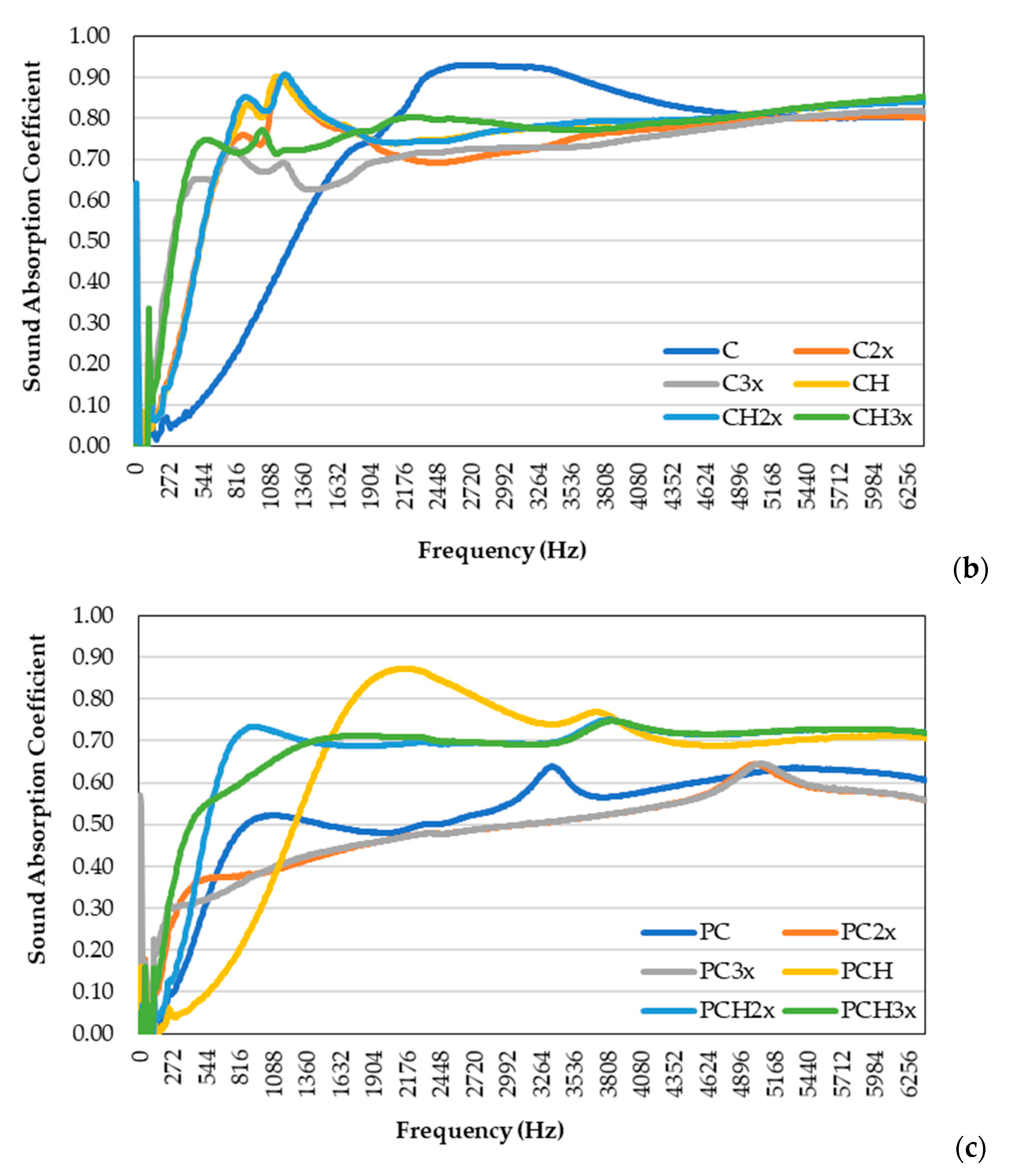
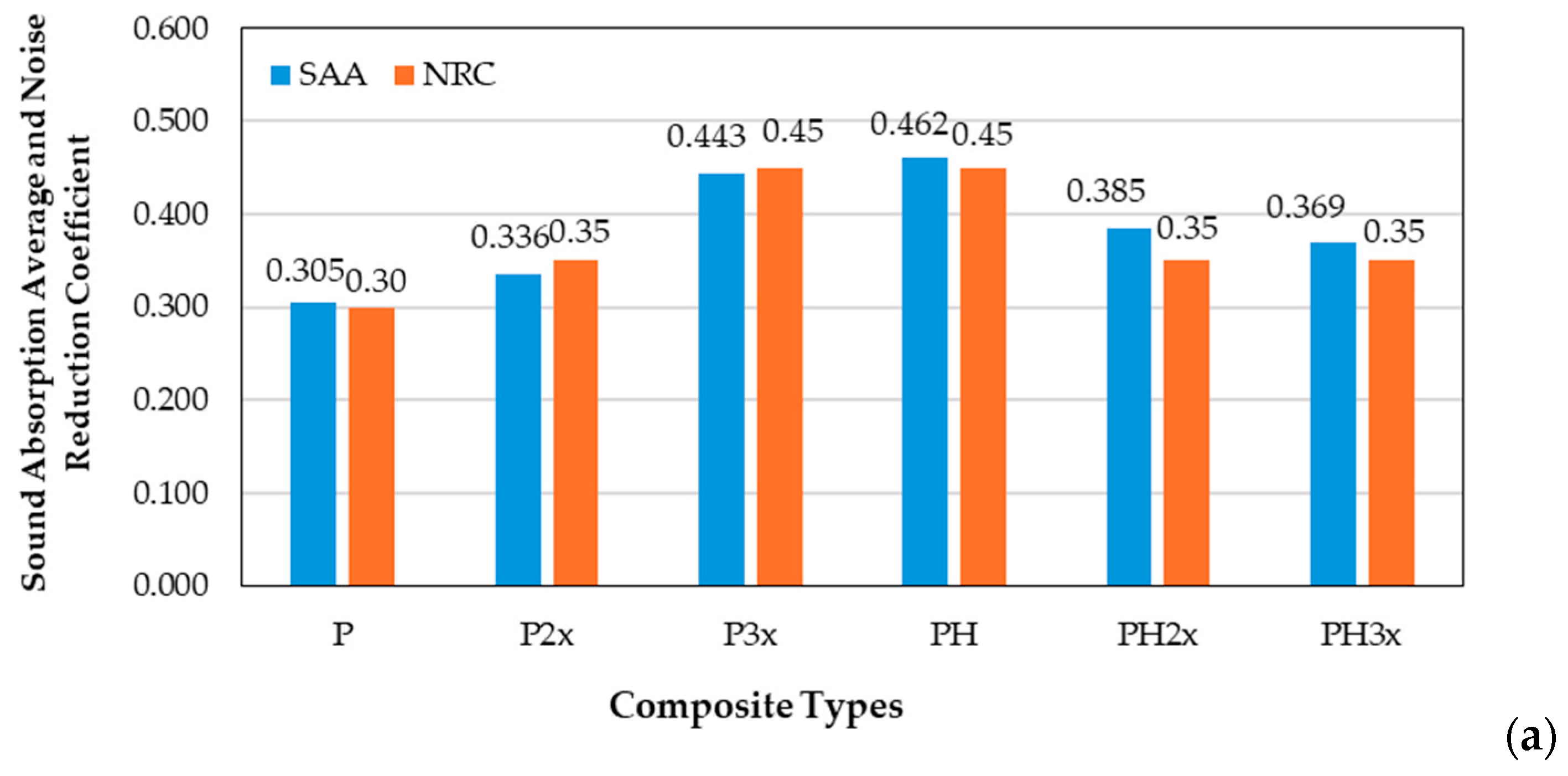
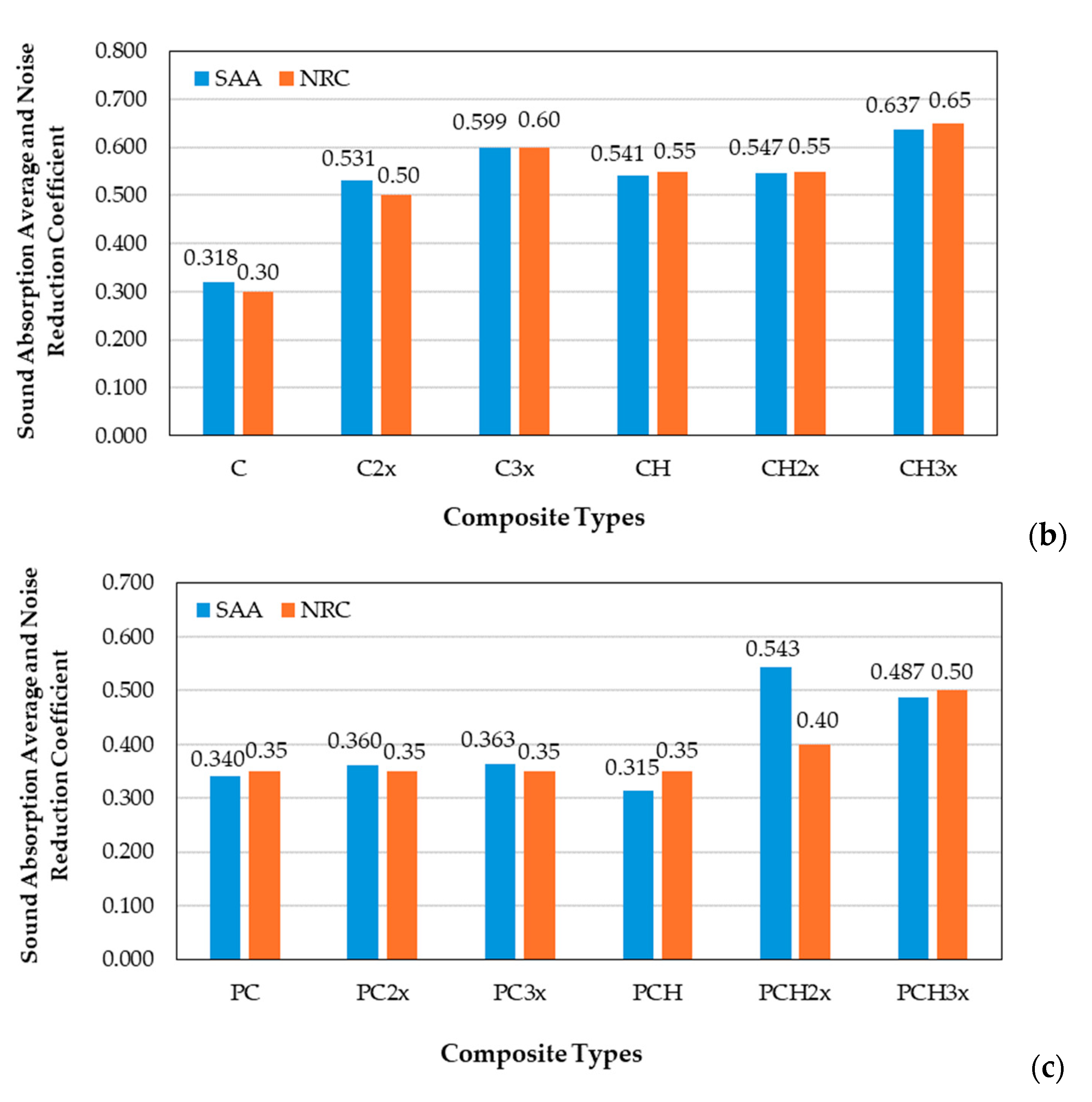
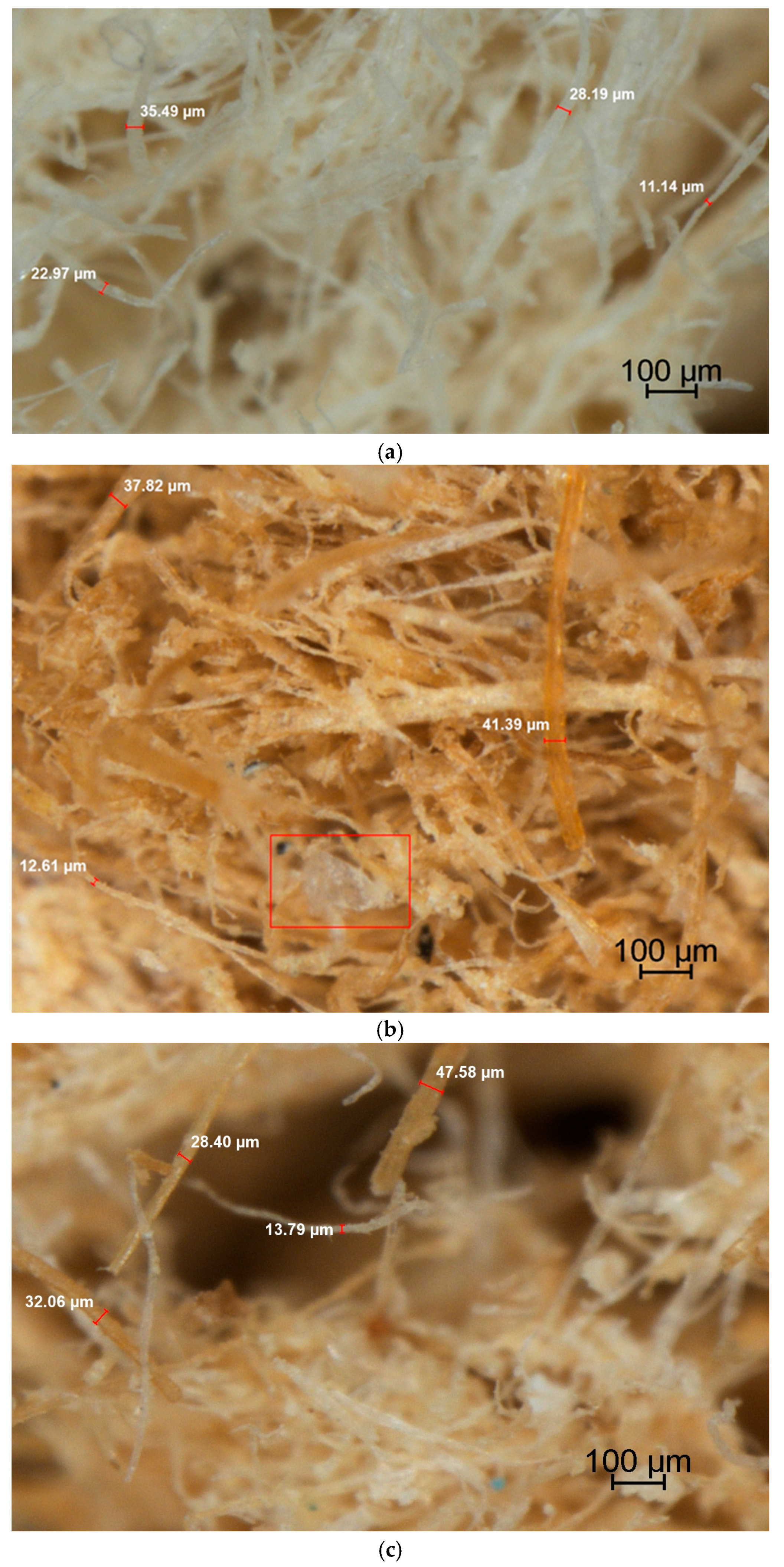
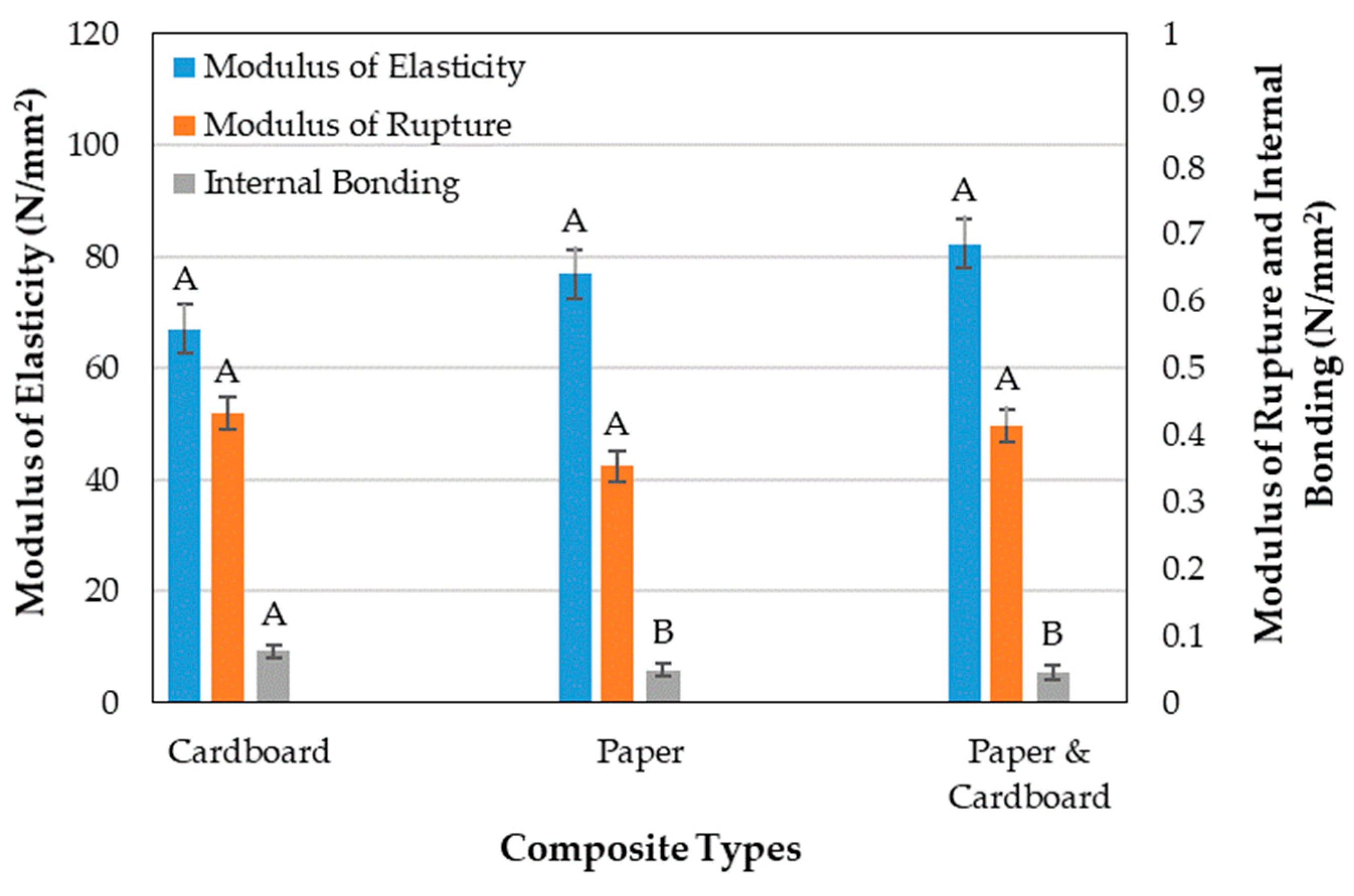
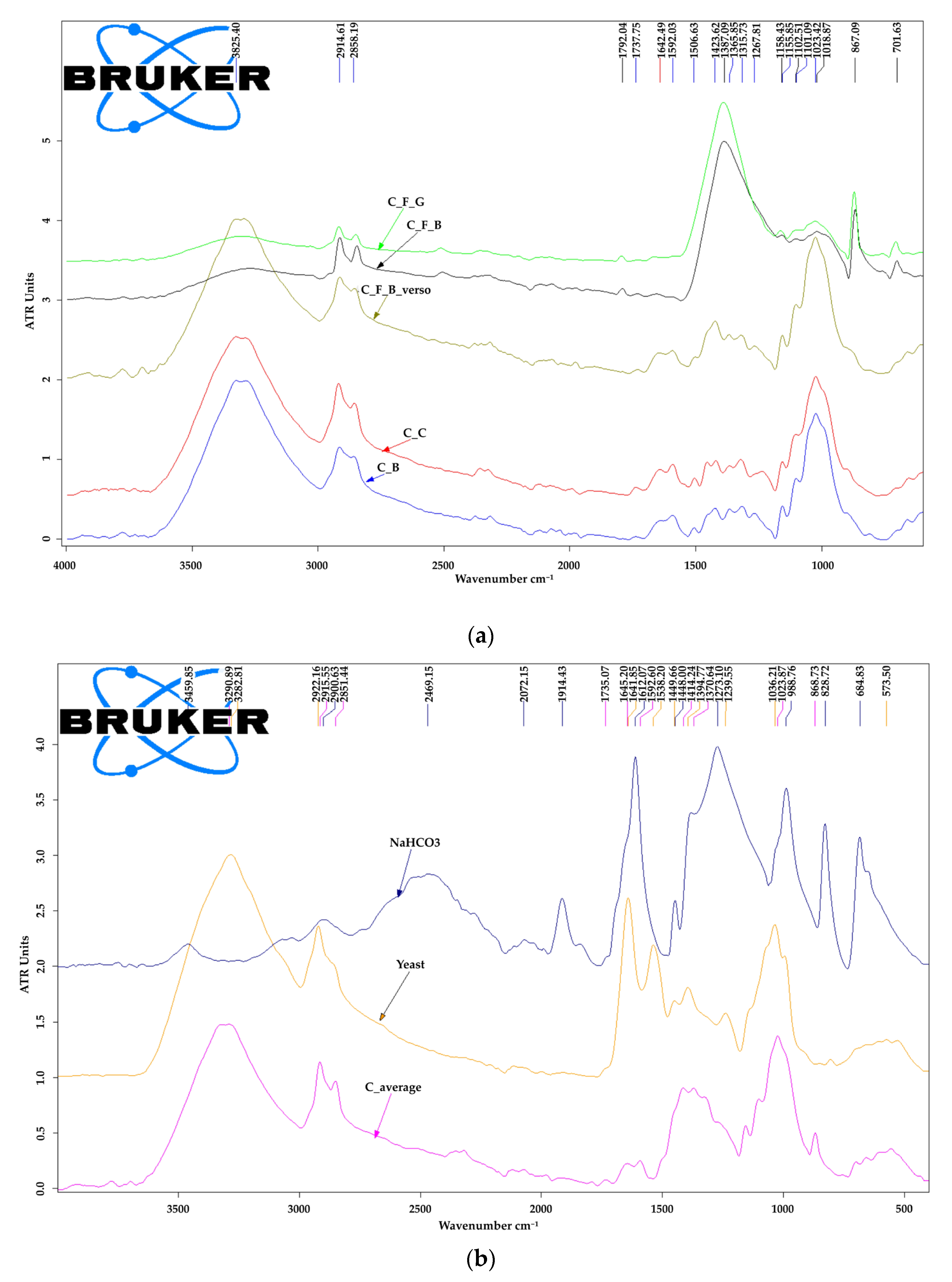
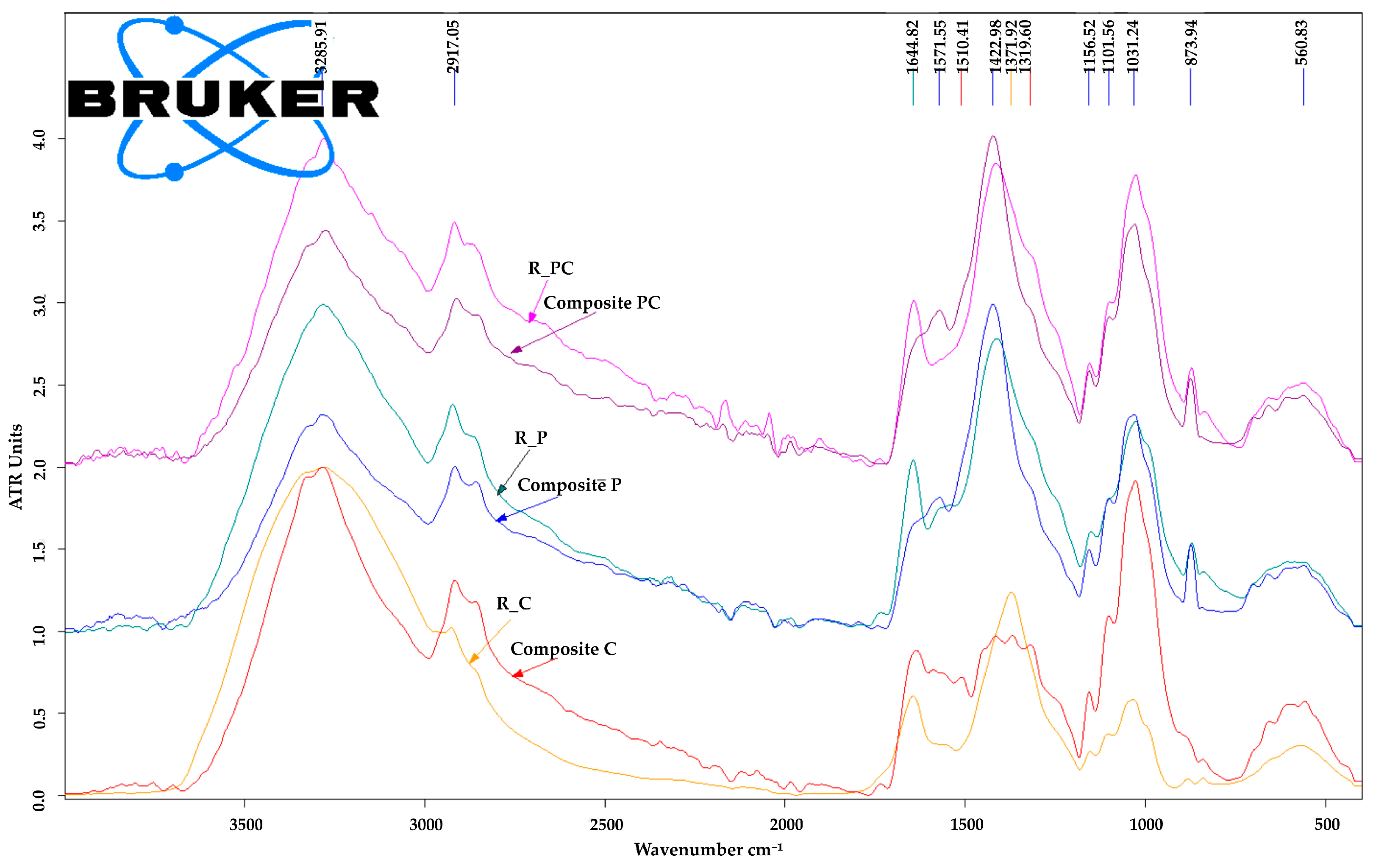
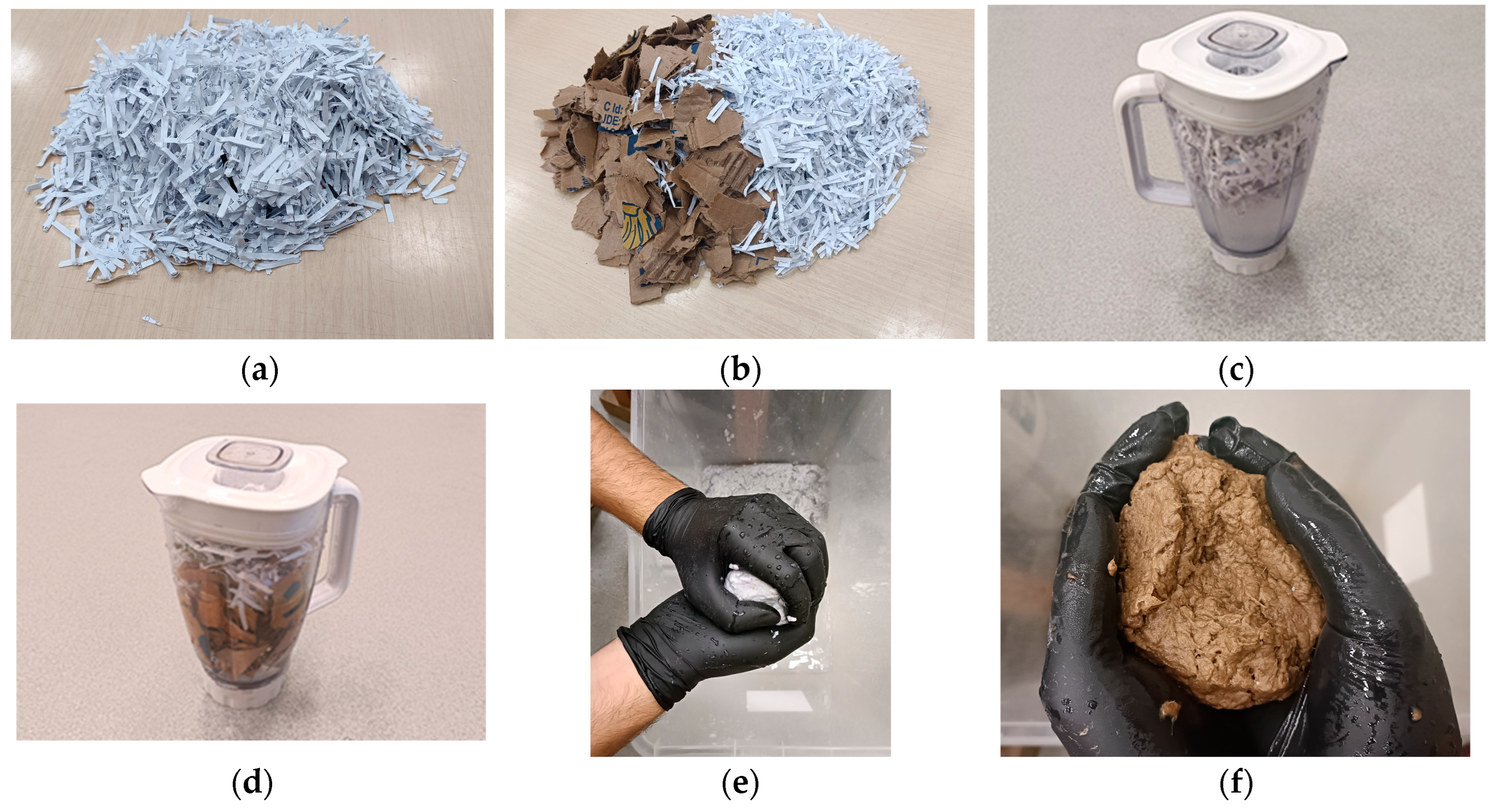


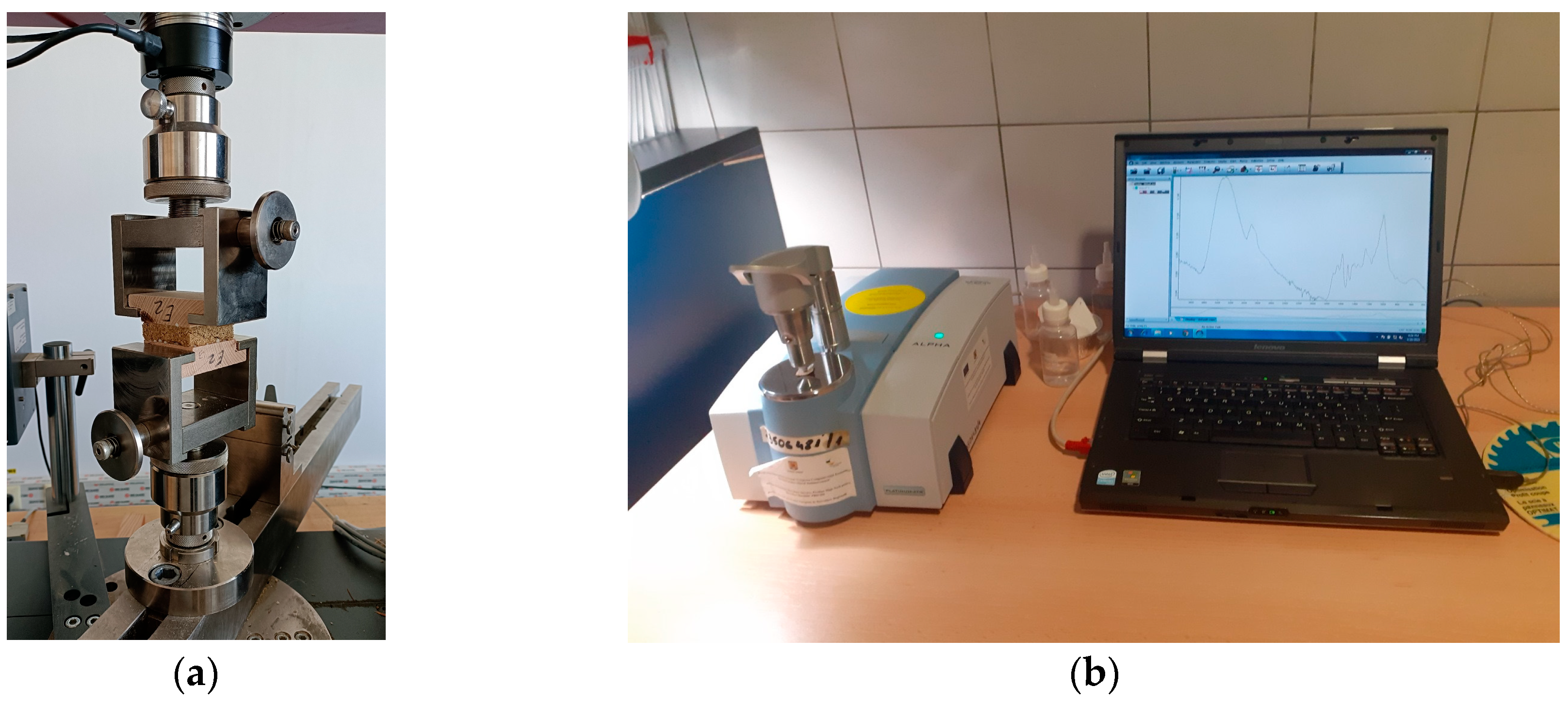
| Code | Density (kg/m3) | Water Absorption (%) | Thickness Swelling (%) | Thermal Conductivity (W/m.K) | Porosity (%) | Flexural (N/mm2) | Internal Bonding (N/mm2) | |||
|---|---|---|---|---|---|---|---|---|---|---|
| 2 h | 24 h | 2 h | 24 h | MOE | MOR | |||||
| P | 220 (10.4) * | 286 (20) | 294 (20) | 4.1 (1.0) | 5.0 (0.8) | 0.053 (0.0008) | 86 | 76.9 (7.26) | 0.35 (0.025) | 0.050 (0.005) |
| C | 161 (5.9) | 560 (20) | 564 (20) | 5.7 (0.8) | 8.6 (1.0) | 0.055 (0.0023) | 90 | 67.1 (18.70) | 0.43 (0.105) | 0.078 (0.022) |
| PC | 216 (7.2) | 258 (20) | 265 (20) | 5.6 (0.8) | 6.8 (1.0) | 0.055 (0.0007) | 87 | 82.4 (16.56) | 0.42 (0.131) | 0.046 (0.019) |
| Code | Composite Type | Raw Material (g) | Water (g) | Sodium Bicarbonate (g) | Yeast (g) |
|---|---|---|---|---|---|
| P | Paper | 500 | 2400 | 450 | 300 |
| C | Cardboard | 500 | 2400 | 450 | 300 |
| PC | Paper-Cardboard | 500 | 2400 | 450 | 300 |
| Structure Code | Structure Components (Thickness) | ||
|---|---|---|---|
| P | C | PC | 1 unperforated layer (30 mm) |
| P2x | C2x | PC2x | 2 unperforated layers (60 mm) |
| P3x | C3x | PC3x | 3 unperforated layers (90 mm) |
| PH | CH | PCH | 1 perforated layer (30 mm) |
| PH2x | CH2x | PCH2x | 2 layers: 1 perforated and 1 unperforated (60 mm) |
| PH3x | CH3x | PCH3x | 3 layers: 1 perforated and 2 unperforated (90 mm) |
Disclaimer/Publisher’s Note: The statements, opinions and data contained in all publications are solely those of the individual author(s) and contributor(s) and not of MDPI and/or the editor(s). MDPI and/or the editor(s) disclaim responsibility for any injury to people or property resulting from any ideas, methods, instructions or products referred to in the content. |
© 2025 by the authors. Licensee MDPI, Basel, Switzerland. This article is an open access article distributed under the terms and conditions of the Creative Commons Attribution (CC BY) license (https://creativecommons.org/licenses/by/4.0/).
Share and Cite
Mazaherifar, M.H.; Lungu, A.; Timar, M.C.; Georgescu, S.V.; Ispas, M.; Cosereanu, C. Properties of Green Foam-Type Composites Made from Recycled Paper and Cardboard. Recycling 2025, 10, 196. https://doi.org/10.3390/recycling10060196
Mazaherifar MH, Lungu A, Timar MC, Georgescu SV, Ispas M, Cosereanu C. Properties of Green Foam-Type Composites Made from Recycled Paper and Cardboard. Recycling. 2025; 10(6):196. https://doi.org/10.3390/recycling10060196
Chicago/Turabian StyleMazaherifar, Mohammad Hassan, Antonela Lungu, Maria Cristina Timar, Sergiu Valeriu Georgescu, Mihai Ispas, and Camelia Cosereanu. 2025. "Properties of Green Foam-Type Composites Made from Recycled Paper and Cardboard" Recycling 10, no. 6: 196. https://doi.org/10.3390/recycling10060196
APA StyleMazaherifar, M. H., Lungu, A., Timar, M. C., Georgescu, S. V., Ispas, M., & Cosereanu, C. (2025). Properties of Green Foam-Type Composites Made from Recycled Paper and Cardboard. Recycling, 10(6), 196. https://doi.org/10.3390/recycling10060196






